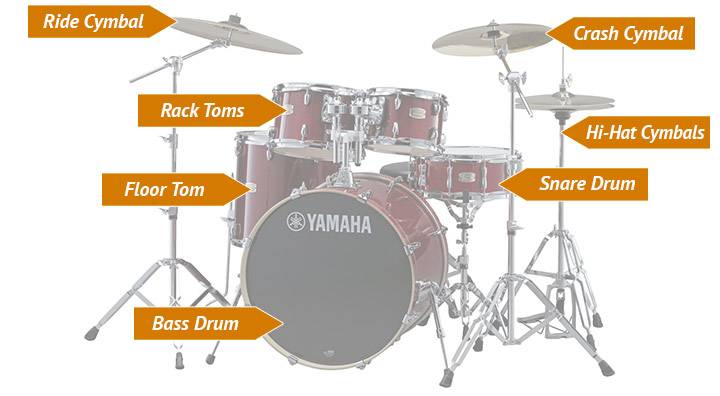Updated: April 21st, 2024
“Yannick, how can I efficiently learn to play drums as a beginner?” – I’ve heard this question so many times that I thought it’s time to write down my exact thoughts of the topic.
If you don’t know how to start your drumming journey the right way – I’m confident this article will make it all clearer. To make it easier on you, dear beginning drummer, I decided to arrange my tips & advices in a step-by-step tutorial. Just follow these 9 steps and you’ll know how to play the drums in no time.
Are you ready to become a drummer?
1. Get Your Essential Equipment
Perhaps you’ll think I’m kidding when I say that the most important piece of “equipment” for drumming is your body. But I’m not joking at all.
Think about it: what enables any drummer on this planet to hit any drum or cymbal on his drum kit? His legs or his feet – which are coordinated by his brain and muscles.
That said, you will need some equipment to engage in your first drumming session – but you don’t need much. For sure, you don’t need to buy a whole drum set just yet. This is great, because I’ve met lots of people who eagerly bought their first drum kit (which isn’t the cheapest thing to do) only to find out that drumming wasn’t as fun as they expected.

So I recommend you to taste the water while spending as little as possible. The first and easiest way to do this is to buy a pair of (very inexpensive) drumsticks, grab a cushion (or a bunch of them), and start hitting it/them. After all, hitting a sturdy cushion is not that different from hitting the pad of an electronic drum kit, so with a little imagination your experience will be the same.
In case you find that this kind of drumming doesn’t really spark your interest – go to a local music store and fool around with a drum set there. Or: get yourself a practice pad and play on that.
One of these 2 methods – or both together – should enable you to decide whether you want to pursue drumming in the first place.
If so, great – you’re in for an amazing ride…
2. Learn How To Hold Drumsticks
Once you’ve completed your first cushion or local store drumming session, it’s time to engage in your first practice session.
Practicing is different from fooling around in that it is way more challenging and requires you to push through barriers to experience a breakthrough. And luckily, this experience too, can be had without a drum kit and still while playing your cushion kit.
To do that properly, though, you need to know how to hold your drumsticks (don’t worry, it’s an easy one):
- Start by standing with your hands at your sides and use your left hand to place one of the sticks in your right hand
- Next, use the flat part of your thumb to press the stick, and wrap the rest of your fingers around. Now, you can repeat the process of placing the next drumstick in your hand.
- While gripping the drumsticks, you should do so behind the balance point or the middle of the stick. Although there are a handful of methods for using your sticks to play your drums, as a beginner, you’ll have plenty of time to try out different techniques and determine what works best for you!
3. Learn Your First Rudiment
At this stage, you’ll be ready to play your first meaningful rhythm as a drummer. Don’t worry, it’s not hard, it will just take some time to adjust to:
And don’t underestimate this rudiment either. While you’re only using the snare drum – or rather your practice pad or cushion – right now, you can make this one simple rhythmic pattern sound like this later on:
And since we want to get you there as soon as possible it’s not time to:
4. Buy a Drum Kit
I don’t think there’s much to say about the “why” here. Yet, the “how” is quite a bit too intricate to cram it into this article.
Instead, go here to find an electronic drum kit (they are helpful if you can’t make too much noise in your practice space) – and here to find the best acoustic drum kit for beginners (the standard option you see on any stage). Also, here you’ll find a selection of cheap drum set options (both acoustic, electronic, and for kids).
5. Get to Know Your Drum Kit
Once you are a proud owner of your first drum kit, I recommend you familiarize yourself with the different parts of your drum kit. This is the prerequisite to play them like a pro as well as to care for them.

Bass Drum
The bass drum, also known as the kick drum, is the largest in the kit. Usually, bass drum shells are made of wood, such as mahogany and maple, but can also be made of some metals. The bass drum works by hitting a petal against it to produce a distinct thumping sound. Also, it’s one of the most essential parts of a drum kit, since it creates the “pulse” of a song.
Snare Drum
The snare drum is the center of a typical five-piece drum kit and in charge of delivering the loud crack you hear during songs. The sound a snare drum makes comes from its shell, which is usually made from wood (maple, mahogany, birch) or metal (bronze, brass, stainless steel), and the sound is triggered whenever you hit the surface of the snare drum called the “drum head”.
Toms, Hi-Hat, and Cymbals
The toms are mounted on top of the bass drum or can be held in place using adjustable legs. There are normally two different types of toms: floor toms and rack toms, which are used during drum fills, and are made from either wood or metal. Other parts of your drum set include the hi-hat and cymbals, which can add accents to your music and allow a transition from one song to the next.
6. Find a Good Teacher
Locating a good drum teacher is perhaps the most crucial step in order to learn to play drums for beginners.

For as much as you can try learning on your own via books you can purchase through online stores – this won’t be as useful as learning from a qualified person at an official local music school. Still, drum lessons can nowadays be taken online just as well as on the premises of a drum school.
In any case, no matter what teacher you hire, it’s crucial you do plenty of research to make sure they fit your needs (learning level) and budget. After all, not everyone can afford a premiere drum teacher – and mostly you don’t need that either.
7. Take Care of Yourself and Your Drums
As important as it is to learn to play drums for beginners, it’s just as essential you take care of yourself and your instrument as well.
You can easily take care of yourself before playing the drums by exercising and stretching your arms and legs. This can help increase blood flow in your body, especially in your limbs, which you’ll need to have in optimal shape to play the drums.
While playing your instrument, it’s also essential you have adequate hearing protection, such as headphones or in-ear monitors. Since the drums can get pretty loud while you’re playing, if you don’t have proper protection, you could eventually end up losing some of your hearing.
Also, since you’ll be sitting down while playing the drums, you must develop proper sitting habits, such as preventing slouching, which can put a strain on your lower back. Work on sitting up straight while playing the drums, even if you get tired.
Finally, I also recommend you take good care of your drum kit to ensure that it will serve you for many years.
That includes cleaning your drums every once in a while and changing your drum heads once they are beaten down. Yet, the most important aspect of caring for your drums – and making them sound good – is to learn to properly tune them and to maintain that tuning over time:
8. Look for Friends to Play With
As a beginning drummer, it’s important to surround yourself with other people who play the drums too.
This won’t only enable you to share your thoughts and opinions of your progress but also motivate you to play together and improve your skill set. Plus: you’ll be making new friends in the process.
So look for a local drumming group, a school or community orchestra, or a neighborhood brass band (despite the name, they do have a rhythm section). Then join and let the magic happen.
9. Start Reading Drum Sheet Music
Now, this is the last and optional step, since technically you don’t need to know sheet music in order to play the drums.

I, however, learned to read sheet music and it helped me tremendously. For example, most music groups require that every musician knows their part – and this is much easier to achieve if every player can just read what’s on their sheets. This spares you from having to memorize, say, a local band’s songs which can easily take a few weeks before you can even start to play together.
Using drum sheet music, too, is a simple but nuanced task, so I’ve put together a comprehensive guide on how to read & write drum sheet music.
Your Questions?
That’s it – the 9 steps I regard as crucial to learning to play drums for beginners.
Try them out and let me know what you think. Or drop me your question in the comments below.
I’ll answer every single one of them (mostly within 24 hours.)
Hi Yannick. exceptional beginners guide on the drums. Many novice musicians are not aware that teachers do not necessarily need any qualifications or experience to become licensed. Your piece highlighting the importance of proper research on potential teachers is as you put it, ‘crucial’
Fantastic post and a great read. As you have stated percussion instruments are often used to imitate sounds of things. This makes them very unique as they give off a much more natural sound than other instruments. However the family of percussion instruments is very large and very wide and learning where to start is very difficult. If you would like to learn more on the family of percussion instruments please visit our post, written by pro-percussionist, Sam Jowett.
Thank you
Mo